Lough Tay | Glendalough | Kilkenny
8 July 2018
You may know by now that I love tea. ‘Teh’ Travels, and all that. But the hospitality of the Irish may have broken me. When we awoke in Enniskerry we were plied with all the fixings for breakfast and sat out in the sun on rocking chairs chatting. Yannick, never one for a savoury breakfast, even ate white pudding (like black pudding but without the blood). He also felt too polite in the face of the lovely spread to tell our hosts that he hated tea. I therefore drank two large mugs of tea so that we didn’t seem ungrateful. I’m certain they would not have thought ill of us if we had left some, but down the hatch they went anyhow. And ill did my stomach think of me once we had profusely thanked them and drove off down the windy village roads, the tea sloshing around. Luckily we stopped soon after to visit Powerscourt Estate, a complex of stately home and gardens on the outskirts of Enniskerry.
 ‘Twas a fine morning, and many others were dropping by to peruse the grounds and neighbouring golf course.
‘Twas a fine morning, and many others were dropping by to peruse the grounds and neighbouring golf course.

We discovered that the main building had been turned into a mall, with a cinema, plant barn, and heaps of little boutiques. This one stocked a range of local and novelty products, and we bought some Skelligs brand gin and tonic flavoured chocolate for the heck of it. (When we tried it later on, Yannick hated it. I wasn’t a fan but it did grow on me a little.)
My stomach was settled, so we drove on to Lough Tay through the most amazing scenery. This was pretty much our first experience of the magnificence of County Wicklow, which derives its name from Víkingaló – “Viking’s Meadow” in Old Norse. (This led me to the belief that in Old Norse, ‘Viking’ was pronounced ‘Wicking’ – it has some comic poetry does it not? Some warrior rushes up, axe in hand, and says he’s a Wicking.)
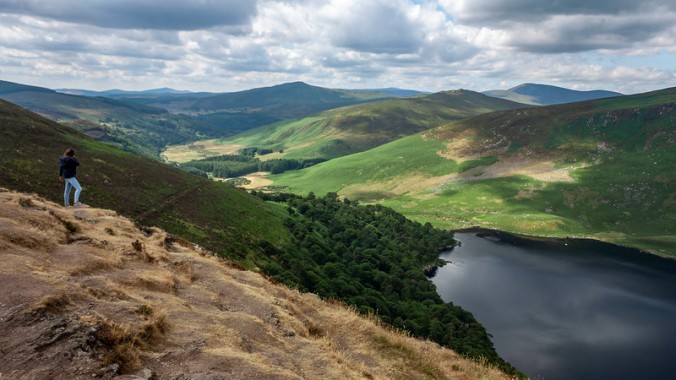
The lough is on privately owned land – land, it is pertinent to add, that belongs to the Guinness family. Yes, that one. So you couldn’t get very close to the lake, but even from the high vantage point, it was stunning.
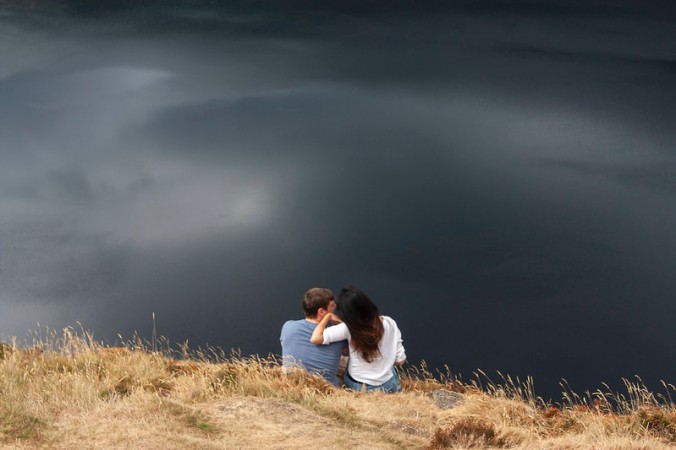
Its black appearance is because of rainwater that filters through peat bogs on its way downhill, making it a dark brown by the time it pools. It is also known as the Guinness Lake because the family imported and laid down a swathe of pale sand on one side so that the whole thing kind of resembles a pint (the black lake being the body of the beer and the sand being the froth on top). Not gonna lie, that feels pretty tacky to me. Leave the loch be, beer barons. When we walked back to our car we found a large tour bus blocking our way. The driver, quietly enjoying a coffee at a food truck, saw me staring him down with my hands on my hips and shifted the bus forward a few meters for us.
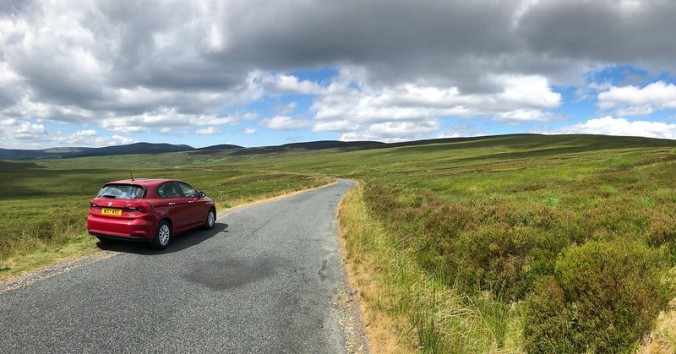
As we drove further into County Wicklow, the landscape flattened out into vast lush plains with hills around us. Heaps of cyclists were taking this route. Up and down we went through valleys – it was awesome and Irish and everything we had wished for this road trip. The first valley was Glenmacnass, a valley that a glacier had carved out in the last Ice Age. We kept on to Glendalough, another glacial valley and the location of a famous monastic site.
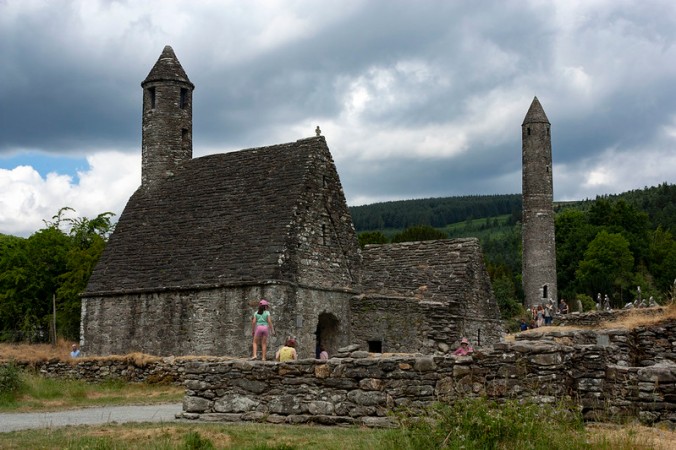
Saint Kevin, an introspective chap, wanted to get away from his large religious following so hermitted himself away in Glendalough in the early sixth century. He slept in a tiny man-made cave and spent his time in prayer. The cave is now known as Saint Kevin’s Bed, and was allegedly used centuries later by Michael Dwyer (an Irish republican) when he was being pursued by British forces. Kevin’s solitude only lasted a few years before disciples found him, begging to be taught, and they ended up building a church. The site expanded over the centuries, and now contains several churches (including Saint Kevin’s Kitchen shown above), a millennia-old Round Tower, and a sprawling graveyard.
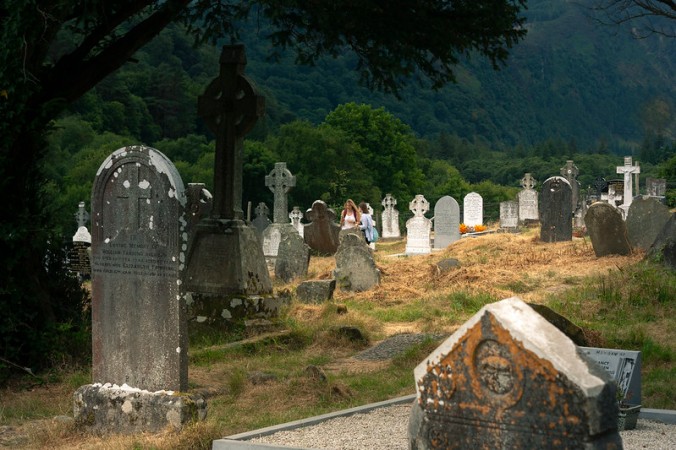
You could feel the history saturating the site, from the twisted trees to the crumbling tombs.
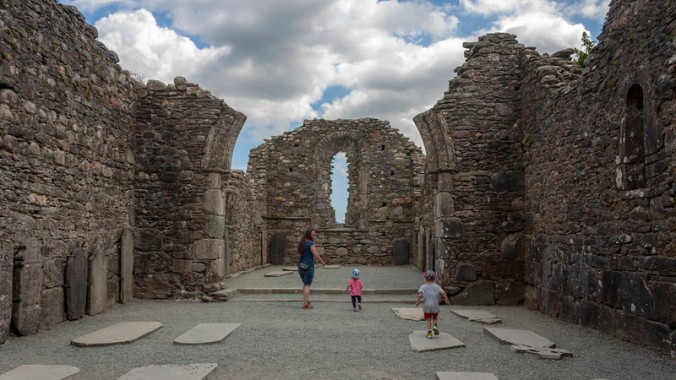
There were even the ruins of a full blown cathedral hulking dimly among the thatch. We left the Lower Glen and walked along to the lake. The path was beautiful with moss- and ivy-clad forest on the left and the river to the right. The lake attracted a smattering of picnic-goers on that clement afternoon.
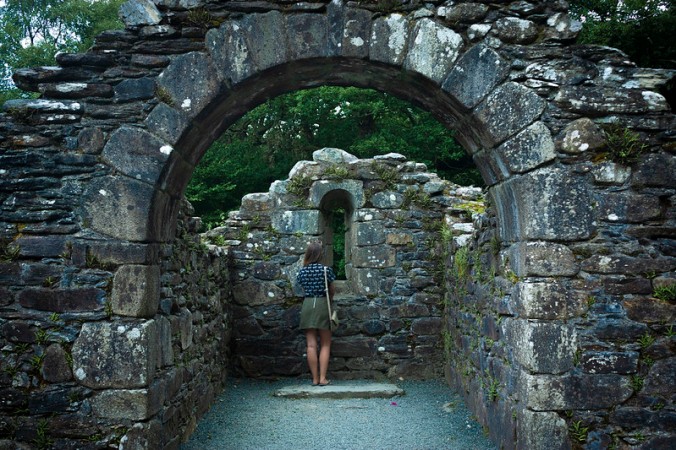
In a little clearing we waded through tall grass to explore Reefert Church. From the Irish ‘Righ Fearta’, the name refers to a burial place of kings – in this instance to the O’Toole family who were local rulers. When you got up close to the walls, you could see the tiniest ferns growing out from between the stones.
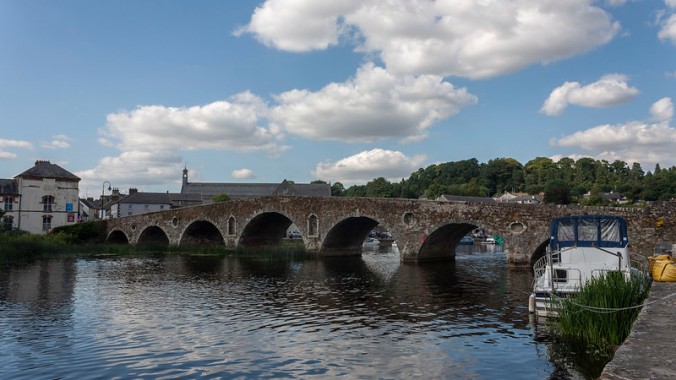
Wanting to end the day two counties further, we pressed on and stopped briefly at the town of Graiguenamanagh, for we had heard tale of an interesting bridge. Built in 1767, the bridge had barely any time to get its bearings before it was blown up during the 1798 Rebellion by the British to prevent the Wexford Rebels from entering Kilkenny. It was rebuilt shortly after, and now abides children leaping from it into the river in hot weather.
Unlike the rebels so many years ago, we traversed the bridge and made it to Kilkenny. When we arrived at the campground, the owner was having a nap. We pitched our tent quick as we could, and took a stroll along the river and canal into town. Such a handy spot for a campsite!
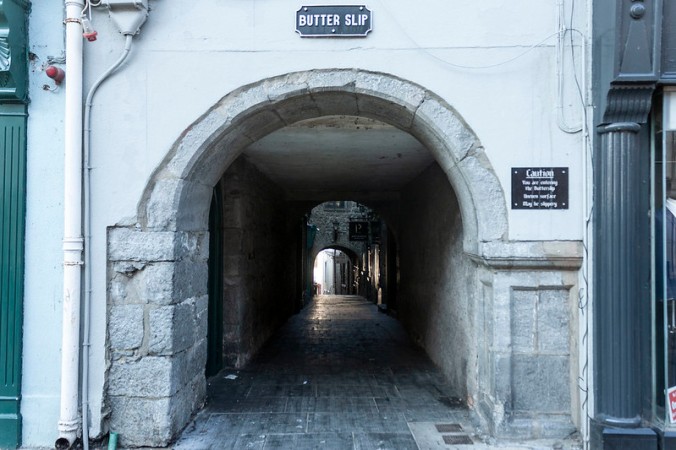
Admiring the castle in passing, we made our way down the cobbled and aptly named High Street. We peeked down alleys and side streets towards the cathedral, the most eye-catching being Butter Slip. It was so named because at the time it was built in the seventeenth century, it was lined with (you guessed it) butter vendors on market days.

This was something I always wondered about, so I’ll share it with you as well: the prefix of ‘Kil’ for Irish place names often comes from the word ‘cill’, meaning church. Occasionally it’s from ‘coill’ meaning forest. It’s not referencing murder at all! The cathedral is that of Saint Canice, which is the ‘Kenny’ part of Kilkenny (this makes more sense when you learn that ‘Chainnigh’ is the Irish form of Canice). Language is complicated. The titular cill has a fraught history that includes fire, allegations of witchcraft, someone trying to patch the hexed roof with lead tiles leading to it falling in from the weight, and Cromwell’s forces defiling it and using it as a stable. Cue Elton’s John’s I’m Still Standing.
As the sun was setting we wandered the town some more to take in the medieval atmosphere. There were plenty of pubs, so we picked one with live music and a reputation for good food: Matt the Miller. It was already hopping but we were lucky enough to snag a corner booth. I got a special vegan menu, while Yannick went with the more traditional Irish stew cooked with Guinness. We revelled in the good meal, conversation, and music via guitarist and flautist duo. On the return walk to the camping, we were a tad cold and had goosebumps or “wee lumpties” as we decided to call them.
Today’s post was almost called: In Which Kevin Hides from His Friends and Kenny is Not Murdered